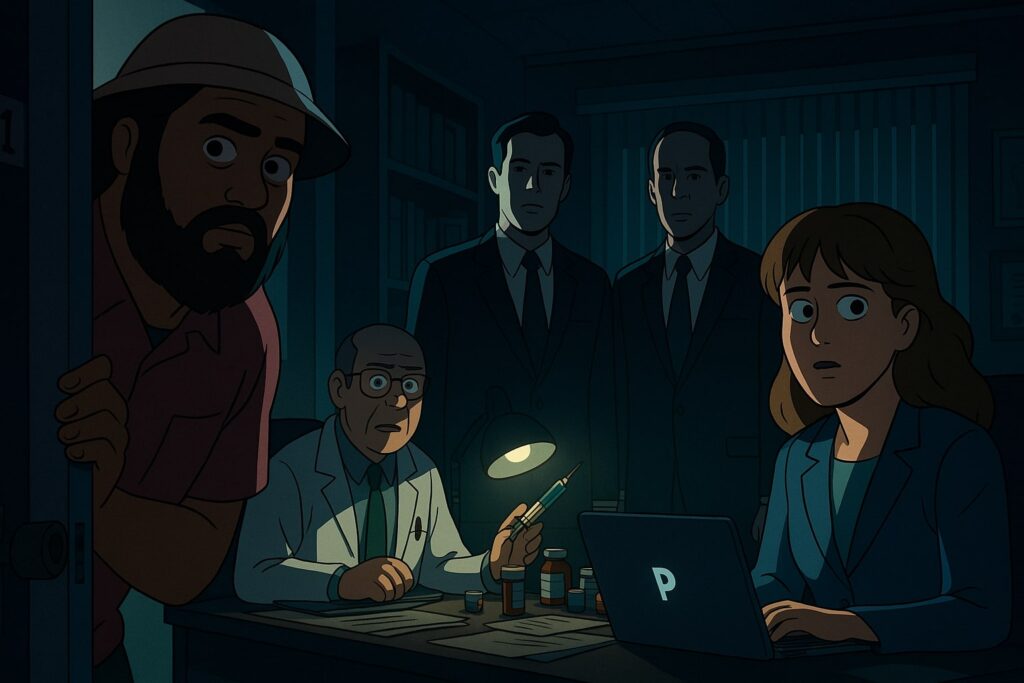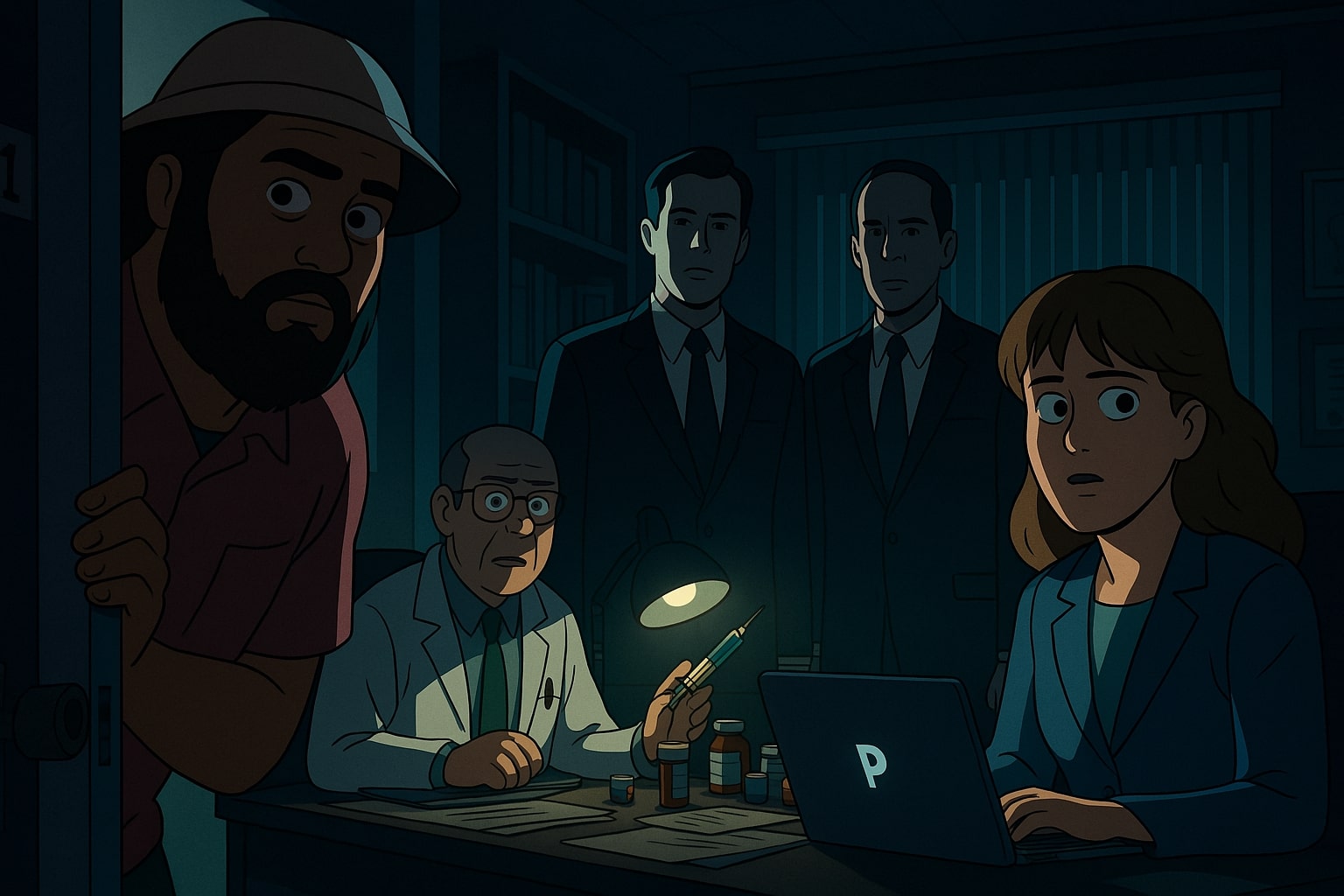It starts with a mushroom. A strange, glowing, borderline-miraculous mushroom. And from there, Common Side Effects spins off into something way bigger: a genre-bending, conspiracy-laced, pharma-roasting trip. But what exactly inspired this wild ride? Turns out, it’s a cocktail of ’90s paranoia, corporate satire, and a whole lot of love for the classics.

Creeping Suspicion and Glowing Fungi
The show kicks off with Marshall Cuso, a mycologist who discovers the Blue Angel mushroom – a fungus with the power to heal basically everything. But instead of being welcomed as a hero, Marshall quickly finds himself hunted by everyone from shady government agents to a desperate pharma CEO. Sounds familiar? That slow-burn paranoia? That sense that someone in a badly lit van is always listening?
Yeah, that’s pure X-Files energy.
Mulder, Meet Marshall
Co-creators Joe Bennett and Steve Hely don’t hide their influences. They’ve said from the jump that Common Side Effects is, in part, an “animated series that takes on Big Pharma with an X-Files-esque slant.” And boy, does it deliver. The shadowy government agents Copano and Harrington basically walked off a Mulder-and-Scully-adjacent set. They’re deadpan, vaguely threatening, and never quite tell you what side they’re on.
A Dash of Coen Brothers, a Shot of Satire
But Common Side Effects isn’t just aliens and paranoia. As Joe Bennett told Polygon, they wanted the tone to land somewhere between Coen brothers films and adult animation. One moment, someone’s hallucinating on mushroom spores. The next, a character gets casually shot mid-conversation. It’s funny, dark, and just absurd enough to make you uncomfortable in all the right ways.
According to Bennett, Coen films were their “North Star”: you can get a laugh, then instantly pivot into shocking violence or genuine sadness. That tonal whiplash? It’s a feature, not a bug.
Visual Easter Eggs and Genre Nods
Fans who grew up on ’90s genre TV will catch the winks. Dimly lit labs. Looming helicopters. Sudden silences before the bad thing happens. From its visual style to its pacing, Common Side Effects plays like a love letter to vintage conspiracy thrillers – but it never goes full pastiche.
Instead, it picks the best parts: suspenseful buildup, cryptic conversations, and just enough surrealism to keep viewers guessing. The paranoia feels earned, not overplayed.
Who’s Watching Whom?
Then there’s the question of surveillance. The show constantly teases a world where someone’s always listening. Drones buzz outside windows. Phone calls glitch. Agents appear without knocking. It echoes The X-Files in spirit but adds a pharma-tech twist.
And that’s where the satire comes roaring in.
Corporate Greed Gets Its Moment
Rick Kruger, CEO of Reutical Pharmaceuticals, is the perfect corporate villain. Played by Mike Judge, he’s both absurdly clueless and scarily competent. One moment he’s praising shareholders, the next he’s ordering black ops missions.
The show skewers Big Pharma’s greatest hits: overpriced drugs, fake science, over-the-top marketing. One fake commercial features a drug with more side effects than benefits. Another episode lampoons internal marketing pitches so tone-deaf, you half-wonder if they’re ripped from real presentations.
Hely Asks the Real Questions
Steve Hely put it best in his chat with the Television Academy: “Why do we spend all this money on healthcare? Why is everybody unhappy… self-medicating? What does it all mean?”
Those questions echo across every plotline. Whether it’s patients desperately seeking a cure or executives trying to suppress one, the message is clear. The system’s broken. The show just makes it funny.
Why It Works
Common Side Effects doesn’t just mash up genres – it refines them. It lets satire wear a tinfoil hat, but also dares to say something honest underneath the paranoia. That delicate balance? That’s what makes the series click.
So next time you watch, keep your eyes peeled:
- Notice the visual callbacks to ’90s thrillers.
- Catch the rhythm of a scene that suddenly flips from funny to fatal.
- Listen for dialogue that feels a little too real.
Behind the Spores and Shadows
In the end, Common Side Effects stands tall not just for what it mocks, but for how cleverly it honors what came before. It’s not just a critique of Big Pharma – it’s a celebration of the weird, eerie, paranoid stories that made us question everything in the first place.
It’s a series that laughs at the system, winks at the viewer, and still finds time to make you paranoid about your cough syrup. Welcome to the new golden age of funny, fungal conspiracy fiction.




